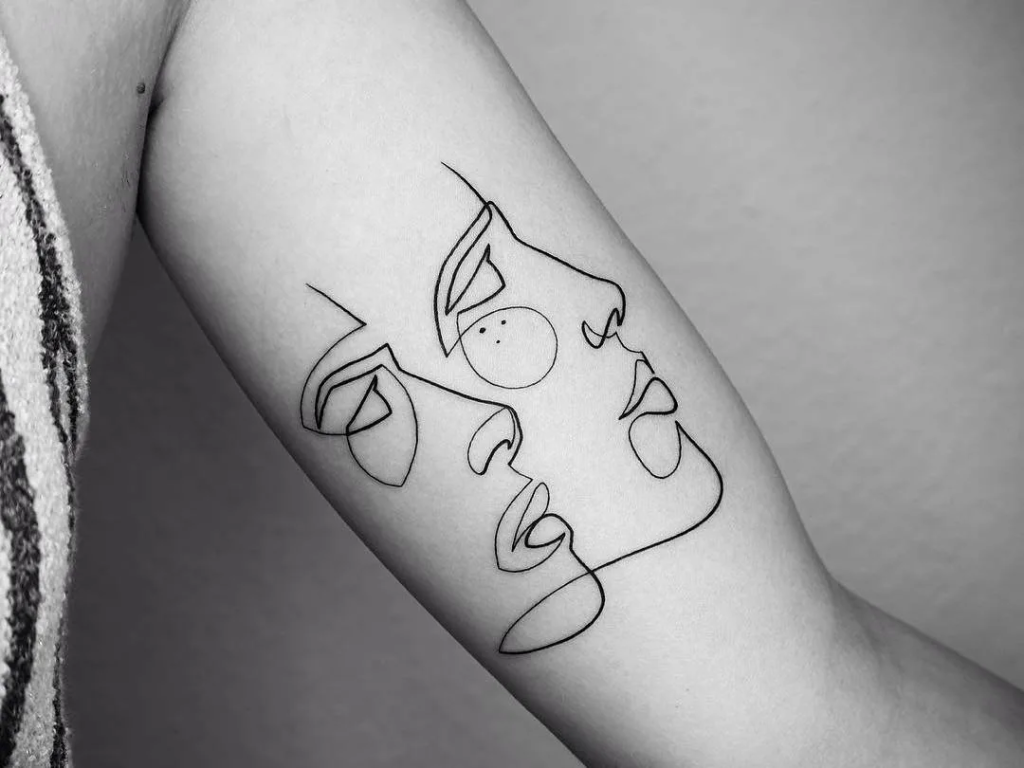If you’ve recently gotten a tattoo, you might be surprised to find that it looks cloudy or milky after it starts peeling. This is a common concern, and it’s an important part of the tattoo healing process. When your tattoo peels, it’s shedding the upper layers of skin that were affected by the tattoo needle, which is both natural and necessary for the healing process. It is during this stage that a temporary cloudiness can appear, making the ink beneath seem less vibrant. The main topic of this article is to explore why this cloudiness occurs and what it means for your tattoo’s healing journey, ultimately revealing how to maintain a clear and vibrant finished piece.
The Aftermath of Getting Inked: Peeling and Cloudiness Explained

When you get a tattoo, the ink is deposited into the dermis, underneath the outer layer of your skin. As the skin heals, the damaged epidermis will begin to flake off, similar to the peeling you experience with a sunburn. This naturally occurring peeling process can cause the tattoo to look cloudy, which is typically a sign that your body is healing itself. During this stage, it’s essential to resist any urges to peel or scratch the area yourself as this can damage the tattoo. Instead, let the skin shed at its own pace. The cloudiness is temporary and should start to clear up as the new skin settles and the healing progresses.
To better understand the variations in healing times, consider the various skin types and aftercare methods used by different individuals. A tattoo may look cloudy for a shorter or longer period depending on these factors. Additionally, environmental conditions like exposure to sunlight or pollutants can affect the healing process and, thus, the cloudy appearance.
Factors Contributing to a Cloudy Tattoo
The cloudiness of a healing tattoo can be attributed to several key factors. Firstly, the quality of ink used and the application technique by the tattoo artist play essential roles. High-quality ink and a skilled artist can minimize complications during the healing process. Secondly, an individual’s skin type has a significant impact. For example, sensitive or oily skin may react differently to tattoos and prolong the cloudy appearance. Lastly, aftercare practices can either accelerate healing or, if neglected, can contribute to an extended cloudy phase. Aftercare routines such as cleansing, moisturizing, and avoiding irritants are crucial for the clarity and longevity of your tattoo.
Let’s delve into these factors in greater detail:
- Ink Quality and Application Technique: Using inferior inks or improper tattooing techniques can result in a less crisp tattoo that takes longer to clarify.
- Skin Type: The nature of each person’s skin – be it dry, oily, or sensitive – can alter the healing process and duration of cloudiness.
- Aftercare Practices: How you take care of your tattoo can determine how quickly the cloudiness resolves. Adhering to aftercare recommendations such as keeping the tattoo clean, using the suggested ointments or lotions, and protecting it from harsh environments can make a significant difference.
Peeling Gone Wrong: Signs of Improper Healing
While peeling is a normal part of the healing process, certain symptoms can indicate complications. If you experience excessive redness, swelling, or heat in the tattooed area, these may be signs of an infection. An allergic reaction is another concern, often characterized by a rash or unusual bumps around the tattoo. Distinguishing between normal healing and problematic symptoms is critical. Proper healing should include some peeling and light itching, but it should not lead to severe discomfort or vivid skin abnormalities.
Determining whether your tattoo is healing improperly can be challenging. Here are signs to look out for:
- Persistent Redness: Redness should subside after the initial few days post-tattoo. If it persists, it may signal an issue.
- Excessive Swelling: Some swelling is normal, but if it continues beyond a few days and is accompanied by pain, consultation with a professional is necessary.
- Foul-smelling Discharge: Any unpleasant odors or discharge coming from the tattoo area could be a sign of infection.
How to Ensure a Clear and Vibrant Tattoo Post-Peeling

To ensure your tattoo remains clear and vibrant after the peeling phase, there are several aftercare tips that can aid the healing process and protect the integrity of your ink. Moisturizing with fragrance-free lotions or ointments is vital, as dry skin can exacerbate peeling and cloudiness. Also, keeping the tattoo clean by gently washing it with mild soap and water can prevent infections that often cause extended cloudiness. Moreover, safeguarding your tattoo from the sun by using SPF or covering it can help maintain the brightness of the colors, as UV rays can fade and blur the ink over time.
For a comprehensive understanding of how to care for your tattoo, here is a simple table summarizing key aftercare steps:
| Action | Benefit |
|---|---|
| Regular Cleansing | Prevents infection and promotes proper healing |
| Moisturizing | Reduces itchiness and flakiness, ensuring a smooth appearance |
| Protecting from Sunlight | Prevents fading and discoloration caused by UV exposure |
| Avoiding Irritants | Diminishes the risk of inflammation and allergic reactions |
Navigating Through the Cloudiness: Tips for Patience and Care
Dealing with a cloudy tattoo requires patience and appropriate care. The healing process is different for everyone and rushing it can lead to complications. Ensuring that you give your tattoo the time it needs to settle is important; this means avoiding the temptation to peel or pick at the flaking skin. The healing phase is not just a physical process but also an exercise in self-restraint. If you’re taking proper care of the tattoo and haven’t witnessed any tell-tale signs of trouble, the cloudiness should clear up in due time. However, if there’s any concern, seeking advice from your tattoo artist or a healthcare professional is the best course of action.
Here are a few important tips to help you navigate through this stage:
- Avoid Picking at the Tattoo: Let the skin shed naturally to prevent scarring or infection.
- Keep the Tattoo Clean and Dry: Gently wash the area with unscented soap and pat dry.
- Stay Hydrated: Drinking plenty of water can help the skin heal more efficiently.
The Light at the End of the Healing Tunnel
As the peeling subsides and cloudiness fades, the true vibrancy of your tattoo will begin to shine. The ink will appear more pronounced and the lines more defined. It is critical to recognize that instant perfection is unrealistic with tattoos; it’s the culmination of good aftercare practices and time that yields stunning results. Once your tattoo fully heals, which can take up to several weeks depending on the size and complexity, you’ll be left with a vibrant piece of body art that you can proudly display.
Conclusion
In conclusion, the cloudiness observed after a tattoo peels is an expected part of the tattoo healing process. It occurs due to the natural shedding of the epidermis as the skin repairs itself. Contributing factors such as ink quality, skin type, and aftercare practices can influence the duration and severity of the cloudiness. By adhering to proper aftercare instructions and being patient, you can navigate through this cloudy phase successfully. Remember, a beautiful and clear tattoo is the reward for those who understand and respect the healing journey.
FAQs
Q1: How long does the cloudy phase typically last after a tattoo starts peeling?
A1: The cloudy phase, also known as the ‘milky’ stage, can last anywhere from a few days to 2 weeks. This period varies depending on individual healing speeds and proper aftercare.
Q2: Is it normal for the tattoo to itch during the cloudy phase?
A2: Yes, it’s normal for the skin to itch as it heals. However, you should avoid scratching the tattooed area to prevent damage or infection.
Q3: Can I do anything to reduce the cloudiness faster?
A3: While the cloudiness is a natural part of the healing process, keeping the area clean and well-moisturized can aid in the healing process. Refrain from picking at the peeling skin and follow your tattoo artist’s aftercare instructions closely.
Q4: Why is my tattoo losing color as it peels?
A4: It may appear that your tattoo is losing color during the peeling phase due to the shedding of the outer layer of skin. This is normal, and the true colors should become more vivid once fully healed.
Q5: Should I be concerned if my tattoo is still cloudy after two weeks?
A5: If your tattoo is still cloudy after two weeks, it may be worth consulting with your tattoo artist or a healthcare professional. Prolonged cloudiness could be due to improper healing or infection.



